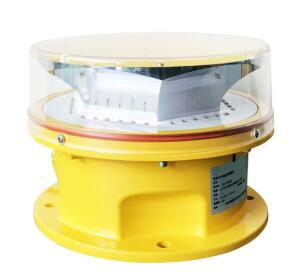Posted: 2024-12-30
Aviation safety is a paramount concern in modern airspace management, and medium intensity aviation obstruction lights play a crucial role in maintaining this safety. These specialized lights are designed to mark tall structures, ensuring they are visible to pilots and reducing the risk of collisions. With advancements in technology and stringent safety regulations, medium intensity aviation obstruction lights have become an indispensable component of aviation infrastructure.
What Are Medium Intensity Aviation Obstruction Lights?
Medium intensity aviation obstruction lights are specialized lighting systems used to mark structures that pose a potential hazard to aircraft. These include buildings, communication towers, wind turbines, cranes, and other tall installations. Operating at a moderate brightness level, these lights are highly effective in making such structures visible to pilots, especially during twilight, night, and low-visibility conditions.
Unlike low-intensity lights, which are used for shorter structures, or high-intensity lights designed for the tallest structures, medium intensity aviation obstruction lights offer an optimal balance. They are bright enough to ensure visibility without causing undue glare or visual distraction.

Key Features of Medium Intensity Aviation Obstruction Lights
The design of medium intensity aviation obstruction lights ensures reliable performance in various operational conditions. Key features include:
LED Technology: Energy-efficient LEDs provide bright and consistent illumination, significantly reducing power consumption and maintenance requirements.
| Medium Intensity Aviation Obstruction Lights |
| Medium Intensity Aviation Obstruction Light |
Durability: Built with weather-resistant materials, these lights are designed to withstand extreme temperatures, high winds, and precipitation.
Visibility: Medium intensity lights emit a range of colors, typically red or white, with steady or flashing modes to meet regulatory requirements.
Integrated Systems: Many lights are equipped with photocells or timers for automatic activation, ensuring they operate only when needed.
Compliance with Standards: Medium intensity aviation obstruction lights adhere to international regulations set by organizations such as the International Civil Aviation Organization (ICAO) and the Federal Aviation Administration (FAA).
Applications of Medium Intensity Aviation Obstruction Lights
Medium intensity aviation obstruction lights are deployed across a variety of structures and scenarios:
Buildings and Skyscrapers: Tall urban structures are marked with these lights to ensure their visibility to aircraft operating at lower altitudes.
Communication Towers: Radio, television, and cellular towers are commonly equipped with these lights to prevent accidental collisions.
Wind Turbines: As renewable energy installations grow, medium intensity lights help mark wind farms, particularly those located in remote or elevated areas.
Cranes: Construction sites with towering cranes rely on these lights to mark temporary hazards.
Airports and Airfields: Structures near runways or flight paths are equipped with these lights to guide pilots safely.
Benefits of Medium Intensity Aviation Obstruction Lights
The use of medium intensity aviation obstruction lights offers numerous advantages:
Enhanced Safety: By marking potential hazards, these lights significantly reduce the risk of collisions in controlled and uncontrolled airspace.
Energy Efficiency: Modern LED-based systems consume less power, making them a cost-effective and environmentally friendly choice.
Long Lifespan: High-quality components ensure these lights have an extended operational life, reducing maintenance costs.
Versatility: Suitable for a wide range of structures, medium intensity lights provide a flexible solution for diverse aviation needs.
Regulatory Compliance: Meeting global aviation standards ensures that these lights contribute to consistent safety practices worldwide.
Innovations in Medium Intensity Aviation Obstruction Lights
Technological advancements are driving the evolution of medium intensity aviation obstruction lights, improving their performance and usability:
Smart Control Systems: Integration with IoT devices allows for remote monitoring and control, enabling operators to manage lights more efficiently.
Hybrid Power Solutions: Solar-powered systems with battery backups offer reliable operation in off-grid locations.
Adaptive Lighting: Advanced sensors adjust the brightness and flashing patterns based on ambient light and weather conditions.
Compact Designs: Smaller, lightweight designs make installation and maintenance easier without compromising functionality.
Choosing the Right Medium Intensity Aviation Obstruction Light
Selecting the appropriate light for a specific application involves several considerations:
Height and Type of Structure: Determine the appropriate intensity and placement based on the structure’s height and purpose.
Environmental Conditions: Opt for lights with weatherproof and corrosion-resistant features suitable for the deployment area.
Power Requirements: Evaluate energy sources and choose lights compatible with the available infrastructure.
Regulatory Standards: Ensure the lights comply with ICAO, FAA, or local aviation guidelines.
Cost and Maintenance: Balance upfront costs with long-term savings by choosing durable, low-maintenance models.
Medium intensity aviation obstruction lights are a critical component of modern aviation safety, providing reliable visibility for structures that could pose risks to aircraft. Their advanced features, energy efficiency, and compliance with global standards make them a preferred choice for a wide range of applications. As technology continues to evolve, these lights will play an even greater role in shaping a safer, more efficient aviation landscape.